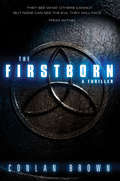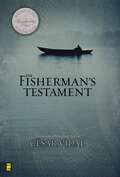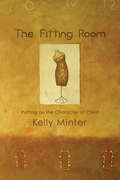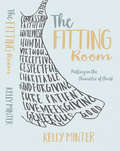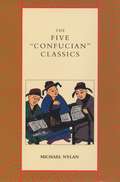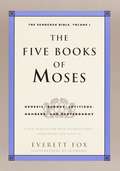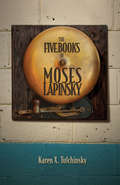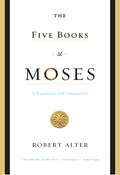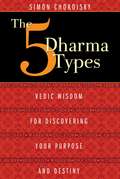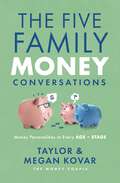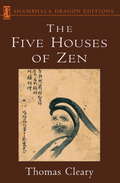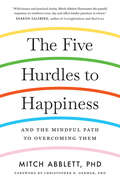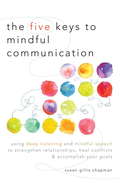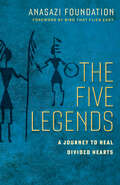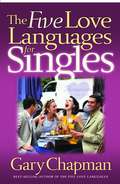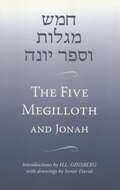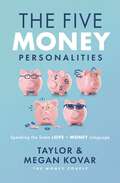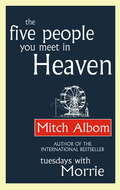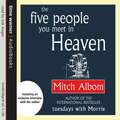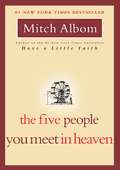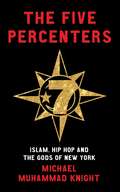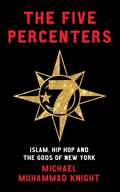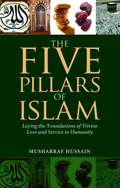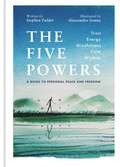- Table View
- List View
The Firstborn: They See What Others Cannot. But None Can See the Evil They Will Face from Within. (The Firstborn #1)
by Conlan BrownThree supernatural gifts. Two thousand years of division. One moment of truth. Hannah’s head hung, long brown hair in her eyes. Her face felt pasty with cold and fatigue and pain. Arms behind her back, she sat in a chair, wrists and ankles tied to the wooden frame, chair legs bolted to the floor. A cold car. A gun. Horror. Pain. Grief. Screaming. A windshield blistering with holes. Darkness. It all came over her like a flood. A pouring out of pictures in her mind. But then there was one more thing. Not an image, but a feeling--that half a continent away someone else had felt it all happening too. The Firstborn--three ancient religious orders gifted with the ability to see past, present, and future--have been divided since the death of Christ. But today, in an era of terrorism and globalization, it has become clear there is an atrocity coming that they must unite to prevent because it is one of them who will perpetrate it. Savage intrigue and a violent power struggle set the stage for three members of the Firstborn as they race against time through a labyrinth of deception and danger to save the lives of hundreds...
The Fisherman's Testament
by Cãesar VidalIn AD 62, Marco Junio Vitalis, a seasoned military general, is assigned to interrogate an elderly Jewish fisherman called Peter and unravels a story that shakes the very foundations of the Roman Empire. Now making its debut in English, this award-winning Spanish bestseller transports readers to ancient Rome where the stakes are high for Christ followers.
The Fitting Room
by Kelly MinterKelly Minter explores what it means--in real life--to "clothe" ourselves (Col. 3:12) in Christian virtues like forgiveness, joy, patience, compassion, and more.Colossians 3:12 tells us to "clothe" ourselves in Christian virtues like forgiveness, joy, patience, compassion. But how does that work in real life? Can we really "dress up" in the character of Christ? Kelly Minter says the answer is yes--if we let the Master Designer do the fitting. This relatable book offers insightful Scripture study with real-life stories and simple, down-to-earth explanations of tricky concepts as justification and sanctification--stitching it all together with dry humor and down-to-earth honesty. There are no gimmicks, no guilt trips, just an irresistible invitation for women to enjoy a spiritual makeover--to put on a life that's personally tailored by the One who knows and loves them best.
The Fitting Room: Putting On the Character of Christ
by Kelly MinterKelly Minter explores what it means—in real life—to “clothe” ourselves (Col. 3:12) in Christian virtues like forgiveness, joy, patience, compassion, and more. Colossians 3:12 tells us to “clothe” ourselves in Christian virtues like forgiveness, joy, patience, compassion. But how does that work in real life? Can we really “dress up” in the character of Christ? Kelly Minter says the answer is yes—if we let the Master Designer do the fitting. This relatable book offers insightful Scripture study with real-life stories and simple, down-to-earth explanations of tricky concepts as justification and sanctification—stitching it all together with dry humor and down-to-earth honesty. There are no gimmicks, no guilt trips, just an irresistible invitation for women to enjoy a spiritual makeover—to put on a life that’s personally tailored by the One who knows and loves them best.
The Five "Confucian" Classics
by Michael NylanMichael Nylan describes how the ancient text has influenced East Asia.
The Five Books Of Moses: Volume I
by Everett FoxEverett Fox's translation re-creates the echoes, allusions, alliterations, and wordplays of the Hebrew original. Together with its extensive commentary and illuminating notes, this unique translation draws the reader closer to the authentic living voice of the Bible.
The Five Books of Moses Lapinsky
by Karen X. TulchinskyCrammed with humour, sorrow, folly, bravery and the richness of the everyday, Tulchinsky's fictional treatment of the Lapinsky family and its remarkable fortunes-through the pivotal moment of the 1933 Toronto race riot, the Great Depression, the rise of fascism and its attendant social tensions, World War II, and the post-war era-brings to life the character of an entire community.
The Five Books of Moses: A Translation with Commentary
by Robert Alter"A modern classic....Thrilling and constantly illuminating."--Michael Dirda, Washington Post Book World Through a distinguished career of critical scholarship and translation, Robert Alter has equipped us to read the Hebrew Bible as a powerful, cohesive work of literature. In this landmark work, Alter's masterly translation and probing commentary combine to give contemporary readers the definitive edition of The Five Books. Winner of the PEN Center USA Literary Award for Translation and the Koret Jewish Book Award for Translation, a Newsweek Top 15 Book, Los Angeles Times Favorite Book, and San Francisco Chronicle Best Book.
The Five Dharma Types: Vedic Wisdom for Discovering Your Purpose and Destiny
by Simon ChokoiskyA handbook for unlocking the soul’s purpose and manifesting a fulfilling life • Reinterprets the traditional Dharma system of ancient India as a map for revealing one’s true purpose • Provides tests for determining one’s Dharma type • Explains the benefits, challenges, and social, interpersonal, and health dynamics associated with each of the 5 Dharma types Have you ever wondered why, despite great obstacles, some people achieve success, while others, though given everything, seem to squander it away? Or why some people, despite having very little, radiate joy, while others appear miserable though surrounded by opulence? The answer is Dharma: knowing your soul’s purpose and living it is the key to creating a fulfilling life. Built on a deep body of Vedic knowledge, the ancient system of social structure and spiritual duty known as Dharma has modern applications for people seeking their life’s purpose. Author Simon Chokoisky explains the five Dharma archetypes--Warrior, Educator, Merchant, Laborer, and Outsider--and how your life’s purpose goes hand-in-hand with your Dharma type. Providing tests to determine your type, he outlines the benefits, challenges, emotional and learning styles, and social, interpersonal, and health dynamics associated with each type. Chokoisky reveals how the Dharma types function as an operating system for your identity, helping you map your life and play to your innate strengths, whether in choosing a prosperous career or field of study or in facing health challenges and meeting fitness goals. By accepting and understanding the nature of your type, you begin to align with your true purpose and, regardless of fate, find joy and meaning in life.
The Five Family Money Conversations: Money Personalities at Every Age and Stage
by Taylor Kovar Megan KovarRaise your hand if your parents had "the talk" with you. No, not that talk. We mean the money talk.Money affects you and your kids every day. Now there's a way to talk about money in a way that actually brings your family closer.With two kids of our own, we suspect our parenting goals are likely the same as yours—no spoiled brats, no crippling debt, and kids who know a dollar actually takes work. That's why we wrote this book. The Five Family Money Conversations offers practical advice for dealing with three age groups (5–12, 13–17, and 18 and beyond). It is the parenting "how to" book you don't want to live without.Conquer the 5 toughest money conversations to have with your kidsDiscover your kids' Money Personalities by taking the age-based Money Personalities Assessment (access code included inside)Learn their Money Languages so you can be heard We give you relationship secrets, share our experiences, and make it fun. Whether your kids are 5 or 25, this book will change the course of your family forever!
The Five Houses of Zen
by Thomas ClearyFor all its emphasis on the direct experience of insight without reliance on the products of the intellect, the Zen tradition has created a huge body of writings. Of this cast literature, the writings associated with the so-called Five Houses of Zen are widely considered to be preeminent. These Five Houses—which arose in China during the ninth and tenth centuries, often referred to as the Golden Age of Zen—were not schools or sects but styles of Zen teaching represented by some of the most outstanding masters in Zen history. The writings of these great Zen teachers are presented here, many translated for the first time. These include: • The sayings of Pai-chang, famous for his Zen dictum "A day without work, a day without food" • Selections from Kuei-shan’s collection of Zen admonitions, considered essential reading by numerous Buddhist teachers • Sun-chi’s unique discussion of the inner meaning of the circular symbol in Zen teaching • Sayings of Huang-po from The Essential Method of Transmission of Mind • Excerpts from The Record of Lin-chi, a great classical text of Zen literature • Ts’ao-shan’s presentation of the famous teaching device known as the Five Ranks • Selections of poetry from the Cascade Collection by Hsueh-tou, renowned for his poetic commentaries on the classic Blue Cliff Record • Yung-ming’s teachings on how to balance the two basic aspects of meditation: concentration and insight
The Five Hurdles to Happiness: And the Mindful Path to Overcoming Them
by Mitch AbblettA practical approach to becoming aware of the "five hindrances"--the negative qualities that inhibit living the awakened life--and to breaking free of them in order to live more mindfully, effectively, compassionately.Five obstacles stand in between you and true happiness. What are they and how can you overcome them? Buddhist traditions teach that there are five negative qualities, or hindrances, that inhibit people from living an awakened life. Here, Mitch Abblett gives this teaching a modern, secular interpretation and helps you identify the hurdles that are blocking your contentment—desire, hostility, sluggishness, worry, and doubt—and how you can take your first steps to overcoming them. Combining traditional wisdom with contemporary psychology and using examples from his psychotherapy practice, Abblett uses the hurdles as a frame for engaging you in a process of contemplating your own life and learning to lean into your experience rather than merely repeating bad habits. By doing this, you can break free from the hurdles and live more mindfully, effectively, and compassionately.
The Five Keys to Mindful Communication: Using Deep Listening and Mindful Speech to Strengthen Relationships, Heal Confli cts, and Accomplish Your Goals
by Susan Gillis ChapmanGood communiation is essential to any healthy relationship, whether it's between spouses, family members, friends, or co-workers. In this book Susan Chapman, a marriage and family therapist and a longtime meditation teacher, explains how mindfulness can be brought to bear in the way we speak and listen to each other so that we can strengthen our connections and better accomplish our goals. Drawing on Buddhist principles and on her training as a psychotherapist, Chapman explains how the practice of mindfulness--learning to become fully present in the moment--makes it possible for us to listen more deeply to others and to develop greater clarity and confidence about how to respond. Chapman highlights five key elements of mindful communication: silence, mirroring, encouraging, discerning, and responding, and she dedicates a chapter of the book to each. Other topics include identifying your communication patterns and habits; uncovering the hidden fears that often sabotage communication; staying open in the midst of difficult conversations so that we can respond wisely and skillfully; and learning how mindful communication can help us to become more truthful, compassionate, and flexible in our relationships.
The Five Legends: A Journey to Heal Divided Hearts
by Anasazi FoundationDrawing on 30 years of helping families in-crisis, this profound fable by the Anasazi Foundation illustrates the anguish of conflict and shows how we can end war within ourselves, within families, and even between nations.The Five Legends tells the story of two estranged brothers, leaders of their people, who find themselves on an unexpected journey. Struggling against each other, they stumble and fall into a great and terrible canyon. Trapped, the two brothers are rescued by an old man—"the last of a people"—who offers to guide them out of the canyon if they agree to learn the five legends of peace. The brothers agree and begin a journey that may not only save themselves, but also their people.The brothers learn that to heal any conflict we must first look within ourselves. As this fable beautifully puts it, "War does not begin or end with armies and leaders. In truth, war begins and ends within each of us—within our hearts. When we choose to war with others, we turn our hearts away from them and blind ourselves to their light. …To have a heart at war is to invite war into your life." The path to peace begins when we stop thinking about "me" and start thinking about "WE."This poetic and moving allegory is written for all ages. Its message is both timeless and desperately needed for our own time
The Five Love Languages For Singles
by Gary ChapmanGary Chapman first penned the bestselling The Five Love Languages more than ten years ago. The core message has hit home with over 5 million people as it focuses on the need to "feel" loved. This need is felt by married and singles alike. Dr. Chapman now tackles the unique circumstances that singles face, and integrates how the same five love languages apply in their relationships. For example, in a business environment, when and how is physical touch appropriate? Take the love language test included.
The Five Megilloth and Jonah
by Jewish Publication Society, Inc.A dual language Hebrew-English editionThese six short books of the Bible, each read in connection with a Jewish holy day, constitute a literature unto themselves—a poetic, spiritual, and literary treasure. This volume includes The Song of Songs, Ruth, Lamentations, Ecclesiastes, Esther, and Jonah.
The Five Money Personalities: Speaking the Same Love and Money Language
by Taylor Kovar Megan KovarFor Richer or For PoorerThe Five Money Personalities has returned in this revised edition by the new Money Couple: Taylor and Megan Kovar.Every couple argues about money. It doesn't matter if you've been married for forty years or dating for four months, money touches every decision you make as a couple. And when the two of you don't see eye to eye on spending and saving, disagreements turn into toxic fights that leave both feeling hurt and angry.But what if you could understand and embrace your unique money differences and transform your financial relationship for the better? The Kovars believe you can do just that by discovering your Money Personalities.Dive into the world of the five Money Personalities to learn about your Primary and Secondary personality:SpenderFlyerSaverSecurity SeekerRisk Taker Once you know your Money Personalities, you can get to the root of your money arguments and begin working together as a team. It's not just about money management, and it's definitely not just about overcoming debt. It is a whole new way of living that will change everything in your relationship.The Five Money Personalities was previously written by Scott and Bethany Palmer.
The Five Paths, (Circle of Three Book #8)
by Isobel BirdThe five-pointed star is the Wiccan symbol of the Spirit, and that's how Cooper wears it. Those not versed in the ways of the Craft find it unsettling, however. Will Cooper, Annie, and Kate be able to withstand the tide of controversy bearing down upon them?
The Five People You Meet In Heaven (Heaven)
by Mitch AlbomTHE INSPIRATIONAL CLASSIC FROM THE MASTER STORYTELLER WHOSE BOOKS HAVE TOUCHED THE HEARTS OF OVER 40 MILLION READERS'Mitch Albom sees the magical in the ordinary' Cecilia AhernPre-order THE STRANGER IN THE LIFEBOAT, Albom's extraordinary new novel now!_________To his mind, Eddie has lived an uninspiring life. Now an old man, his job is to fix rides at a seaside amusement park.On his eighty-third birthday, Eddie's time on earth comes to an end. When a cart falls from the fairground, he rushes to save a little girl's life and tragically dies in the attempt. When Eddie awakens, he learns that the afterlife is not a destination, but a place where your existence is explained to you by five people - some of whom you knew, others who were ostensibly strangers.One by one, from childhood to soldier to old age, five individuals revisit their connections to Eddie on earth, illuminating the mysteries of his 'meaningless' life and revealing the haunting secret behind the eternal question: 'Why was I here?'__________WHAT READERS SAYS ABOUT THE FIVE PEOPLE YOU MEET IN HEAVEN'Breathtakingly beautiful. A story that will stay with you forever''A beautiful and flawlessly choreographed book . . . No other book may ever compare''One of my favourite books . . . Wonderful, inspirational, and heart-warming! To me, it is a MUST READ!'The book is beyond words . . . Well written, engaging, poignant''This really is a wonderful book. You should read it'
The Five People You Meet In Heaven (Heaven)
by Mitch AlbomTHE FIVE PEOPLE YOU MEET IN HEAVEN is a wonderfully moving fable that addresses the meaning of life, and life after death, in the poignant way that made TUESDAYS WITH MORRIE such an astonishing book. The protagonist is an elderly amusement park maintenance worker named Eddie who, while operating a ride called the 'Free Fall', dies while trying to save a young girl who gets in the way of a falling cart that hurtles to earth. Eddie goes to heaven, where he meets five people who were unexpectedly instrumental in some way in his life. While each guide takes him through heaven, Eddie learns a little bit more about what his time on earth meant, what he was supposed to have learned, and what his true purpose on earth was. Throughout there are dramatic flashbacks where we see scenes from his troubled childhood, his years in the army in the Philippines jungle, and with his first and only love, his wife Marguerite. THE FIVE PEOPLE YOU MEET IN HEAVEN is the perfect follow up to TUESDAYS WITH MORRIE. Its compellingly affecting themes and lyrical telling will fascinate Mitch Albom's huge readership.
The Five People You Meet in Heaven
by Mitch AlbomFrom the bestselling author of Tuesdays with Morrie, a war veteran encounters the true significance of life after death in this touching modern classic. On his 83rd birthday, Eddie dies in a tragic amusement park ride accident in an attempt to save a little girl&’s life. He awakens in the afterlife, where he learns that heaven is not a lush Garden of Eden, but a place where your earthly life is explained to you by both loved ones and distant strangers. As the story builds to its stunning conclusion, Eddie desperately seeks redemption in the still-unknown last act of his life: Was it a heroic success or a devastating failure? The answer, which comes from the most unlikely of sources, is as inspirational as a glimpse of heaven itself. In The Five People You Meet in Heaven, Mitch Albom will change everything you&’ve ever thought about the afterlife—and the meaning of our lives here on earth.
The Five Percenters: Islam, Hip-hop and the Gods of New York
by Michael Muhammad KnightWith a cast of characters ranging from Malcolm X to 50 Cent, Knight’s compelling work is the first detailed account of the movement inextricably linked with black empowerment, Islam, New York, and hip-hop. Containing unrivalled insider access to the movement’s elders, oral histories, and community literature, this fast-paced investigation uncovers the Five Percenters’ icons and heritage, and examines their growing influence in urban American youth culture. Including coverage of Brooklyn turf gangs, the Attica prison uprising, 1980s crack empires, and the stars of Five Percenter rap, Knight explores the origins and development of this controversial community, and reveals the hidden reality behind the myths, rumours, and hearsay. Michael Muhammad Knight converted to Islam at the age of sixteen after reading the autobiography of Malcolm X. He is the author of The Taqwacores, the cult novel credited with inspiring 'Muslim Punk Rock'.
The Five Percenters: Islam, Hip-hop and the Gods of New York
by Michael Muhammad KnightWith a cast of characters ranging from Malcolm X to 50 Cent, Knight's compelling work is the first detailed account of the movement inextricably linked with black empowerment, Islam, New York, and hip-hop. Containing unrivalled insider access to the movement's elders, oral histories, and community literature, this fast-paced investigation uncovers the Five Percenters' icons and heritage, and examines their growing influence in urban American youth culture. Including coverage of Brooklyn turf gangs, the Attica prison uprising, 1980s crack empires, and the stars of Five Percenter rap, Knight explores the origins and development of this controversial community, and reveals the hidden reality behind the myths, rumours, and hearsay. Michael Muhammad Knight converted to Islam at the age of sixteen after reading the autobiography of Malcolm X. He is the author of The Taqwacores, the cult novel credited with inspiring 'Muslim Punk Rock'.
The Five Pillars of Islam
by Musharraf HussainThe Five Pillars of Islam is a comprehensive and practical manual on the fundamental beliefs and practices of a Muslim and provides an understanding of the true spirit of worship in Islam. Written by a noted Muslim scholar and educationist with a contemporary Muslim audience in mind, this is an invaluable reference for every home and classroom.Musharraf Hussain, PhD, is the director of the Karimia Institute in the United Kingdom. In 2009 he was awarded the Order of the British Empire for his services to community relations in Britain.
The Five Powers: A guide to personal peace and freedom
by Stephen Fulder'In a direct and lovely way, Stephen, a meditation teacher and a peacemaker in Israel and Palestine shows us how to steady our hearts, how to live and embody trust and wisdom in an uncertain world.' - Jack Kornfield, author of A Path With Heart'This book is not only a deeply wise and practical guide for spiritual awakening, it is also gorgeous! Highly recommended for all who seek the blessings of inner freedom.' - Tara Brach, the Author of Radical AcceptanceTRUST + ENERGY + MINDFULNESS + CALM + WISDOMIt can all feel a bit too much. We find ourselves occupied, morning to night, with reacting, responding and coping with uncontrollable and often challenging circumstances. How can we rise above stress, anxiety and frustration? How do we perform a restart? Is it possible to radically transform our daily life? And how might we invite deeper meaning and freedom into our lives? For many, the gateway to the Buddhist teachings is Mindfulness. And Mindfulness is indeed one of the Five Powers that are regarded as the original teachings of the Buddha: 1. Trust 2. Energy3. Mindfulness4. Calm5. WisdomHow do these Five Powers help us to discover personal peace and freedom? We begin with Trust, a leap of faith, letting go of the sides and getting into the stream of life. But in order to swim well, we also need Energy to overcome resistance and keep going. Mindfulness brings our awareness to where we are on the path in each moment, to notice life in its rich detail. Inner freedom expands, amplified by the peaceful power of Calm. We focus on what is right in front of us, we listen intently, we are patient with life. And Wisdom provides our inner knowing, our compass. With stunning artwork throughout by the acclaimed artist Alessandro Sanna, The Five Powers is a guide for those who seek the freedom to be themselves, to love fully and to dance with the unexpected and embrace the everyday.
